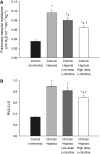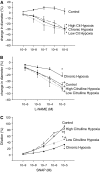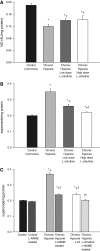Rescue Treatment with L-Citrulline Inhibits Hypoxia-Induced Pulmonary Hypertension in Newborn Pigs
- PMID: 25536367
- PMCID: PMC4566047
- DOI: 10.1165/rcmb.2014-0351OC
Rescue Treatment with L-Citrulline Inhibits Hypoxia-Induced Pulmonary Hypertension in Newborn Pigs
Abstract
Infants with cardiopulmonary disorders associated with hypoxia develop pulmonary hypertension. We previously showed that initiation of oral L-citrulline before and continued throughout hypoxic exposure improves nitric oxide (NO) production and ameliorates pulmonary hypertension in newborn piglets. Rescue treatments, initiated after the onset of pulmonary hypertension, better approximate clinical strategies. Mechanisms by which L-citrulline improves NO production merit elucidation. The objective of this study was to determine whether starting L-citrulline after the onset of pulmonary hypertension inhibits disease progression and improves NO production by recoupling endothelial NO synthase (eNOS). Hypoxic and normoxic (control) piglets were studied. Some hypoxic piglets received oral L-citrulline starting on Day 3 of hypoxia and continuing throughout the remaining 7 days of hypoxic exposure. Catheters were placed for hemodynamic measurements, and pulmonary arteries were dissected to assess NO production and eNOS dimer-to-monomer ratios (a measure of eNOS coupling). Pulmonary vascular resistance was lower in L-citrulline-treated hypoxic piglets than in untreated hypoxic piglets but was higher than in normoxic controls. NO production and eNOS dimer-to-monomer ratios were greater in pulmonary arteries from L-citrulline-treated than from untreated hypoxic animals but were lower than in normoxic controls. When started after disease onset, oral L-citrulline treatment improves NO production by recoupling eNOS and inhibits the further development of chronic hypoxia-induced pulmonary hypertension in newborn piglets. Oral L-citrulline may be a novel strategy to halt or reverse pulmonary hypertension in infants suffering from cardiopulmonary conditions associated with hypoxia.
Keywords: nitric oxide signaling; superoxide; uncoupled eNOS.
Figures







Similar articles
-
Folic acid, either solely or combined with L-citrulline, improves NO signaling and ameliorates chronic hypoxia-induced pulmonary hypertension in newborn pigs.Physiol Rep. 2021 Nov;9(21):e15096. doi: 10.14814/phy2.15096. Physiol Rep. 2021. PMID: 34762361 Free PMC article.
-
Tetrahydrobiopterin oral therapy recouples eNOS and ameliorates chronic hypoxia-induced pulmonary hypertension in newborn pigs.Am J Physiol Lung Cell Mol Physiol. 2016 Oct 1;311(4):L743-L753. doi: 10.1152/ajplung.00238.2016. Epub 2016 Aug 19. Am J Physiol Lung Cell Mol Physiol. 2016. PMID: 27542807 Free PMC article.
-
Combined l-citrulline and tetrahydrobiopterin therapy improves NO signaling and ameliorates chronic hypoxia-induced pulmonary hypertension in newborn pigs.Am J Physiol Lung Cell Mol Physiol. 2020 Apr 1;318(4):L762-L772. doi: 10.1152/ajplung.00280.2019. Epub 2020 Feb 19. Am J Physiol Lung Cell Mol Physiol. 2020. PMID: 32073878 Free PMC article.
-
L-citrulline provides a novel strategy for treating chronic pulmonary hypertension in newborn infants.Acta Paediatr. 2014 Oct;103(10):1019-26. doi: 10.1111/apa.12707. Epub 2014 Jun 20. Acta Paediatr. 2014. PMID: 24862864 Free PMC article. Review.
-
Pathogenetic role of eNOS uncoupling in cardiopulmonary disorders.Free Radic Biol Med. 2011 Apr 1;50(7):765-76. doi: 10.1016/j.freeradbiomed.2010.12.018. Epub 2010 Dec 21. Free Radic Biol Med. 2011. PMID: 21172428 Review.
Cited by
-
Changes in the nitric oxide pathway of the pulmonary vasculature after exposure to hypoxia in swine model of neonatal pulmonary vascular disease.Physiol Rep. 2018 Oct;6(20):e13889. doi: 10.14814/phy2.13889. Physiol Rep. 2018. PMID: 30375198 Free PMC article.
-
MiR-125a regulates mitochondrial homeostasis through targeting mitofusin 1 to control hypoxic pulmonary vascular remodeling.J Mol Med (Berl). 2017 Sep;95(9):977-993. doi: 10.1007/s00109-017-1541-5. Epub 2017 Jun 7. J Mol Med (Berl). 2017. PMID: 28593577
-
Folic acid, either solely or combined with L-citrulline, improves NO signaling and ameliorates chronic hypoxia-induced pulmonary hypertension in newborn pigs.Physiol Rep. 2021 Nov;9(21):e15096. doi: 10.14814/phy2.15096. Physiol Rep. 2021. PMID: 34762361 Free PMC article.
-
Effects of supplemental citrulline on thermal and intestinal morphology parameters during heat stress and feed restriction in growing pigs.J Anim Sci. 2024 Jan 3;102:skae120. doi: 10.1093/jas/skae120. J Anim Sci. 2024. PMID: 38812469 Free PMC article.
-
Pharmacologic strategies in neonatal pulmonary hypertension other than nitric oxide.Semin Perinatol. 2016 Apr;40(3):160-73. doi: 10.1053/j.semperi.2015.12.004. Epub 2016 Jan 14. Semin Perinatol. 2016. PMID: 26778236 Free PMC article. Review.
References
-
- Mourani PM, Abman SH. Pulmonary vascular disease in bronchopulmonary dysplasia: pulmonary hypertension and beyond. Curr Opin Pediatr. 2013;25:329–337. - PubMed
-
- Stenmark KR, Abman SH. Lung vascular development: implications for the pathogenesis of bronchopulmonary dysplasia. Annu Rev Physiol. 2005;67:623–661. - PubMed
-
- Khemani E, McElhinney DB, Rhein L, Andrade O, Lacro RV, Thomas KC, Mullen MP. Pulmonary artery hypertension in formerly premature infants with bronchopulmonary dysplasia: clinical features and outcomes in the surfactant era. Pediatrics. 2007;120:1260–1269. - PubMed
-
- Fike CD, Aschner JL, Zhang Y, Kaplowitz MR. Impaired NO signaling in small pulmonary arteries of chronically hypoxic newborn piglets. Am J Physiol Lung Cell Mol Physiol. 2004;286:L1244–L1254. - PubMed
Publication types
MeSH terms
Substances
Grants and funding
LinkOut - more resources
Full Text Sources
Other Literature Sources
Medical

